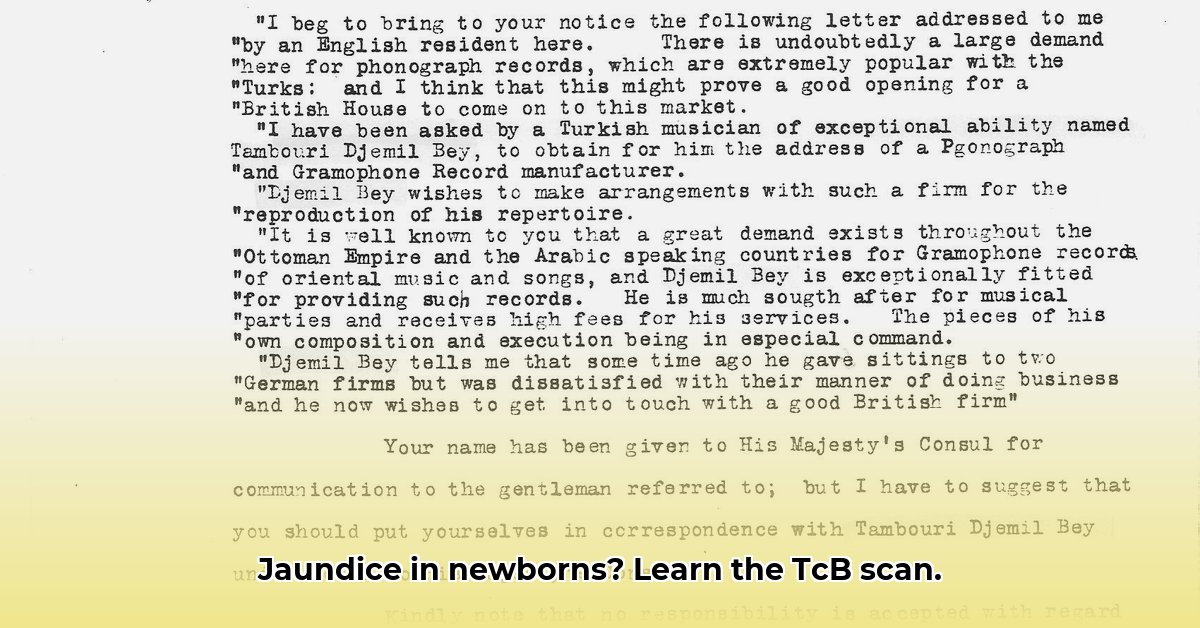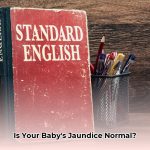Jaundice in newborns is a common concern for new parents. This article provides a comprehensive guide to transcutaneous bilirubin (TcB) measurement, a non-invasive test used to screen for jaundice. We’ll explain how TcB measurement works, its accuracy, how to interpret the results, and available treatment options. For more information on newborn bilirubin testing, see this bilirubin scan resource. This knowledge will empower you to confidently care for your newborn and address any concerns about jaundice.
Neonatal Jaundice and the Importance of Early Detection
Jaundice, characterized by a yellowish discoloration of the skin and eyes, affects many newborns. It occurs due to elevated levels of bilirubin, a yellow pigment produced during the breakdown of red blood cells. Newborns often have higher bilirubin levels because they have a greater number of red blood cells with shorter lifespans, and their livers are still developing and may not efficiently process bilirubin.
While mild jaundice is usually harmless and resolves on its own, high bilirubin levels can, in rare cases, pose risks to the baby’s developing brain. Therefore, monitoring bilirubin levels is crucial, and TcB measurement offers a convenient and non-invasive method for early detection.
What is Transcutaneous Bilirubin (TcB) Measurement?
TcB measurement is a non-invasive screening method used to estimate bilirubin levels in a newborn’s skin without requiring a blood sample. A portable, handheld device called a bilirubinometer is used. The device gently touches the baby’s forehead or sternum.
The bilirubinometer emits a brief flash of light that penetrates the skin. It then analyzes the light reflected back, measuring the intensity of specific wavelengths. The device calculates the bilirubin level based on how the skin absorbs and reflects the light. The entire process is quick, painless, and provides an immediate estimate of bilirubin levels.
TcB measurement serves as a screening tool to determine if further testing with a blood test (Total Serum Bilirubin or TSB) is necessary. It helps reduce the number of painful blood draws for newborns while ensuring timely evaluation of elevated bilirubin levels.
Accuracy of TcB Measurement Compared to TSB
While TcB measurement is a valuable screening tool, it’s essential to understand its accuracy in comparison to a TSB blood test. TSB is considered the gold standard for measuring bilirubin levels as it provides a direct measurement of bilirubin concentration in the blood.
TcB measurement estimates bilirubin levels in the skin and subcutaneous tissue. TcB readings correlate well with blood levels, but it is not a direct replacement for TSB. TcB measurements are most accurate at lower bilirubin levels. At higher levels, the correlation between TcB and TSB may decrease.
Factors such as skin pigmentation and gestational age can also influence TcB accuracy. Babies with darker skin tones may have slightly less accurate TcB readings. Premature infants may also exhibit variations in TcB accuracy due to differences in skin maturity.
If a TcB reading is high or approaches a predetermined threshold based on the baby’s age, a TSB blood test is typically performed to confirm the results and guide treatment decisions.
Interpreting TcB Measurement Results
TcB results should always be interpreted by a healthcare professional, taking into account the baby’s age in hours, gestational age, and any other relevant clinical factors. Healthcare providers use age-specific nomograms (charts that plot bilirubin levels against the infant’s age in hours) to assess the risk of hyperbilirubinemia (high bilirubin levels).
A TcB reading is plotted on the nomogram to determine the percentile risk zone. A reading in a lower percentile indicates a low risk, while a reading in the 95th percentile or higher suggests a high risk of developing significant hyperbilirubinemia.
Gestational age also plays a role in interpreting TcB results. Premature infants often have higher bilirubin levels than full-term infants due to their less mature liver function.
Treatment Options for Neonatal Jaundice
If a newborn’s bilirubin levels are elevated and require treatment, the most common intervention is phototherapy. Phototherapy involves exposing the baby to special blue lights that convert bilirubin into a water-soluble form, making it easier for the body to excrete through urine and stool.
During phototherapy, the baby is placed under the blue lights, wearing only a diaper and eye protection to shield their eyes from the intense light. Phototherapy is generally safe and effective in reducing bilirubin levels.
In rare cases, if phototherapy is insufficient to lower bilirubin levels, an exchange transfusion may be considered. This procedure involves gradually removing the baby’s blood and replacing it with donor blood to rapidly lower bilirubin levels. Exchange transfusions are reserved for severe cases of hyperbilirubinemia.
When to Seek Medical Advice
Parents should contact their pediatrician promptly if they notice any of the following signs of jaundice in their newborn:
- Yellowing of the skin or eyes
- Poor feeding or decreased appetite
- Lethargy or excessive sleepiness
- High-pitched cry
- Difficulty waking up
Early detection and treatment of jaundice can prevent serious complications.
Frequently Asked Questions (FAQ) about TcB Measurement
- Is TcB measurement painful for my baby? No, TcB measurement is completely painless and non-invasive.
- How long does the TcB measurement take? The procedure takes only a few seconds.
- Can TcB measurement be performed at home? TcB measurement is typically performed in a hospital, clinic, or during a home visit by a healthcare professional.
- What happens if my baby’s TcB level is high? Your healthcare provider will explain the next steps, which may include a blood test to confirm the results and possible treatment with phototherapy.
Pros and Cons of TcB Measurement
| Feature | Pros | Cons |
|---|---|---|
| Procedure | Non-invasive, painless, quick, readily available, reduces the need for blood draws, can be performed at the bedside or in an outpatient setting. | Less accurate than a TSB blood test, especially at high bilirubin levels. Accuracy can be affected by skin tone, gestational age, and other factors. |
| Results | Provides immediate results, allows for quick assessment and decision-making. | Requires interpretation by a healthcare professional, may require follow-up TSB blood test for confirmation. |
| Cost-Effectiveness | Reduces the number of blood tests performed, potentially lowering healthcare costs, serves as an effective screening tool to identify newborns who require further evaluation and intervention. | May lead to unnecessary follow-up testing if TcB results are borderline, still requires access to trained personnel and equipment, and may not be available in all healthcare settings. |
Disclaimer: This article provides general information about TcB measurement and neonatal jaundice. It is not a substitute for professional medical advice. Always consult with your pediatrician or healthcare provider for diagnosis and treatment of any medical condition.
- Water Wheel Electric Generator Provides Free Home Electricity - December 15, 2025
- Choosing the Right Portable Hydro Turbine for Your Needs - December 14, 2025
- Best Portable Hydro Generators for Off-Grid and Outdoor Power - December 13, 2025
















